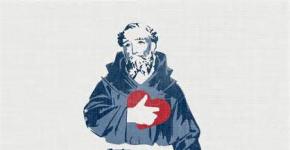Writers who processed Russian folk tales. Russian folk tales processed by Alexei Nikolaevich Tolstoy
list of books / Russians folk tales processed by Alexey Nikolaevich Tolstoy
Russian folk tales processed by Alexei Nikolaevich Tolstoy
Tolstoy Alexey Nikolaevich
M, " Children's literature", 1987
Alexey Nikolaevich Tolstoy (lived 1883 - 1945) is a writer of multifaceted and brilliant talent. He created novels about modernity and the historical past of our Motherland, stories and plays, scripts and political pamphlets, autobiographical stories and fairy tales for children. A.N. Tolstoy was born in the city of Nikolaevsk, Samara province - now the city of Pugachev, Saratov region. He grew up in the wild life of the bankrupt Trans-Volga landowners. The writer colorfully depicted this life in his stories and novels written in 1909 - 1912, “Mishuka Nalymov”, “Cranks”, “The Lame Master”.
Alexey Tolstoy did not immediately accept the October Revolution. He emigrated abroad. "Life in exile was the most difficult period my life,” Tolstoy later wrote in his autobiography. “There I understood what it meant to be a pariah, a person cut off from his homeland, weightless, ethereal, not needed by anyone under any circumstances.” Longing for the Motherland evoked Tolstoy’s childhood memories, paintings native nature,. This is how the autobiographical story “Nikita’s Childhood” (1919) appeared.
Returning to his homeland in 1923, Tolstoy wrote: “I have become a participant in a new life on earth. I see the tasks of the era.” Alexey Nikolaevich writes the stories “Black Friday”, “Mirage”, “Union of Five”, the science fiction novel “Engineer Garin’s Hyperboloid”, the trilogy “Walking in Torment” and historical novel"Peter 1". For children younger age A. N. Tolstoy wrote the fairy tale “The Golden Key, or the Adventures of Pinocchio.”
Alexei Nikolaevich Tolstoy devoted a large section of his work to collecting Russian folk tales and preparing the text of fairy tales for publication in children's collections. Writers who took on folk tales valued the folk language very much. Alexey Nikolaevich Tolstoy, whose editors edited the audio fairy tales for this audio collection, wrote that in a fairy tale it is important to preserve “the folk language, wit, freshness, originality, the very manner of the story, the conversation” - “the folk style.” If handled carelessly, it disappears in the same way “as the wondrous and fragile pattern of a butterfly’s wings disappears at the clumsy touch of human fingers.”
The audio collection includes Russian folk audio tales from "Russian Folk Tales" - 1 volume of "Fairy Tales of the Peoples of the World", Moscow publishing house "Children's Literature" 1987, processed and retold by A. N. Tolstoy.
We invite you to get acquainted with the biography of A. N. Tolstoy in the “Authors” field, listen online to your favorite audio fairy tale, or download a Russian folk audio fairy tale for free and without registration, processed by Alexei Nikolaevich Tolstoy and annotations for audio fairy tales.
On the bench, his crying mother sits with her aunt, whom he was supposed to spend the night with. They have drawn up a plan for the conquest of Prague, which they receive through their slings and one dump. All their money was given by the prostitute to gunpowder. But the buckwheat ran through the money from the children and was eventually arrested by a policeman when he did not want to leave the market.
Written about the souls of this year Fat Miss Mary remained an old virgin. She once loved her with the love of two Maltese flamingos, the merchant Chibulka and the engraver Rechner. When Mary refused Mr. Rechner, Mr. Chibulka denied that he could not live with her in luck when his best friend was in despair. They both came out of the marriage with mutual respect. Miss Mary thought he loved her, so he gave them a wreath every year at Dusichka. She then goes to see her girlfriend, Widow Nokaru, who compares her life to being sad and lonely.
Russian folk audio tale “Go there - I don’t know where, bring that, I don’t know what”, arranged by Alexei Nikolaevich Tolstoy. Similar tales are taken into account in the folklore of many countries in Europe, Asia, Canada and South America. In the twentieth century, it served as the basis for Leonid Filatov’s wonderful classic fairy tale “About Fedot the Archer, a Daring Young Man.” Wise...
Figures - an idyllic fragment from a lawyer's notebooks Thirty-year-old lawyer Krumlovsky decides to file a lawsuit and goes to the quiet Small Town to study there. But the people in the house - the figures - are still scattering it. She lives with a seductive guide, whose lover - a lieutenant - asks Krumlov to fight for slander. Krumlovsky will win thanks to the quick surprise attack that his friend taught him. His wife always sits when they have money. Krumlovsky decides to raise Pepik morally, but he does not.
Another neighbor is Provaznik, who likes to write anonymous letters. This freak is like irony and everyone laughs. He never leaves home to avoid meeting strangers. The master of the house is a hypochondrist who loses his memory and still gets back on his feet. My daughter Otilia takes care of him. Krumlovsky will be visited by his friend Dr. Jensen, who works at the Institute of Mental Health. Krumlov thinks Jensen is interested in Othello, so he falls in love with her too. But when he finds out that his friend comes here only to observe Provaznik, who used to be his patient, Otilets's feelings are cold.
Russian folk audio tale adapted by A. N. Tolstoy “Ivan the Cow’s Son” is a magical tale about wonderful events. Three boys were born on the same day: Ivan Tsarevich, Ivan the girl's son and Ivan the cow's son. All three Ivans grew by leaps and bounds, all grew up to be heroes. Already at ten years old they had no equal in strength. Further, to develop the wonderful...
Krumlovsky moves to an earlier apartment. Stories about the Small Town. Prague: Czechoslovakian writer. Folk tales set in a historical land and ethnographic region located in central Poland, in the Wielkopolska Lake District, the central Vistula basin and the Upper Notcze, with the main cities being Wloclawek, Inowroclaw, Kruszwica and Bydgoszcz. Kujawy was subject to cultural and economic influences from neighboring regions and was not unified in terms of dialects, ethnic and cultural - they are divided into Kujawi Biała, Polne, Borowe, Lane, Czarne and Bahorn.
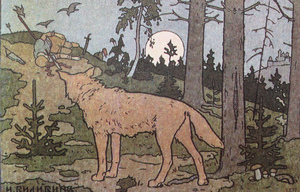
Russian folk audio tale "Ivan the Tsarevich and the Gray Wolf" adapted by A. N. Tolstoy. One of the most popular world cycles. Numerous East Slavic variants have close correspondence with texts in collections of non-Slavic peoples of the USSR. The oldest European literary version is in the Latin collection of Johannes Gabius (1480). From XIII in....
The national structure of Kuyavi also included Jews, Ukrainians and Gypsies. Consequently, among ethnographers of Kujawa tales you can find reports representing many → folk motifs commonly found in other regions of Poland. The earliest were recorded by Kujawski folklore collectors → local claims.
Among them were 4 entries in Coles County, in Lubstuv, where threads of fairy tales and one story were realized. An important point on the topic of folk tales in Kujawski was the publication of Jerzy Wojciech Sulczewski in the second volume of Zasinków on folklore of the Poznań province. There were 50 stories and stories about the Kujawian translation in the German translation, which the collector divided into 5 thematic groups: small → musicians, beggars, apprentices, artisans, → robbers, → thieves and → gypsies, → witches, devils and nightmares.
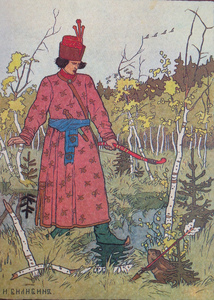
Russian folk audio tale "The Frog Princess" arranged by Alexei Nikolaevich Tolstoy. The originality of the option is the presence of numerous details. In such tales it changes social status sons who chose brides and the brides themselves, as well as the tasks that they were asked to perform. The trials that befall you may vary...
Karol Maslowski in his brief description ethnography. Kujaw recorded some local claims related to the churches in Kruszyn and Kowal, and the miraculous image of the saint. Dig in Klobets. The most famous of them were those that were organized in subsequent years, and the following 6 stories, faithful to archival records and the style of their authors, were prepared by Hanna Lopatyńska for publication.
There are many themes in Kujawy that are common in other areas of Poland, as early regional folklore collectors have already noted. Two tales based on this theme were also included in Sulczewski's collection. The hero, as in many other regions of Poland, bears a name that suggests that he appeared in the world as a result of the physiological activity of his parents - the release of gastrointestinal gases. One of the women was her children and her husband. He walks one day without a forest and meets a hedgehog and says: “This God will give us a hedgehog.”

Russian folk audio "The Tale of Rejuvenating Apples and Living Water" arranged by A. N. Tolstoy. A combination of plots partially used in the folklore of Europe, Asia, Africa and America, in East Slavic records, as well as in the Arabian Nights, medieval chivalric romances, and the Latin collection of Johannes Gabius. The first Russian popular prints...
God gave it so. And she was happy with this hedgehog, and the owner was happy. Kujawic fairy tales are characterized by the motif of a glass pumpkin, a cottage, or a water ball. According to records recorded by Lucian Siemienski, glass gourd was known in Kujawski in the ancient times of the legendary King Popil in Kruszwice.
Popiel, wanting to hide from the intrusive mice, ordered a large piece of glass to be made, in which he locked himself with his wife and children, and therefore ordered to be released to Lake Goplo, but this also did not help, because the mice bit and chewed Popiel. However, in Kuyavi, in texts that implement other magical threads, a glass pumpkin or cottage appears, associated with attempts to kill the heroes rather than saving them. The entire family was placed, Michalka, the princess and the son were taken into a large glass sphere and thrown into the sea.
Russian folk audio tale "Sivka-Burka" adapted by A. N. Tolstoy. The plot is known in European countries, as well as in Afro-Asian folklore. Among the literary adaptations - a fairy tale in verse by the English poet of the 18th century Alexander Pope, a fairy tale by K.F. Nikolai (Germany), short story American writer Washington Irving "Prince Ahmed Kamal" (1825), Czech...
The entire family was expected to drown or die of hunger and thirst. And the ball headed towards the island. Popular bandits are also popular heroes of Kujawa oral traditions. In stories relating to authentic events, specific people are mentioned: Madaj - a giant with ugly face, whose fate is characteristic of the thread T 756B → “Madjou Bed”, Gydy masters in opening locks. There is also a story about the brutal revenge of the bully Spocac.
When the robber Spoczac remained in the forest near Strzelno, one day a worker gave him a loot from which he stole a goat. For fear of capture, Spochak had to flee in other directions. To do this, he took revenge on the worker's wife in the following way. As she walked into town, he backed toward her, jumped out of hiding, gave her six cents, and told her to buy him nails and a bottle of vinegar. The woman did not know the robber and did not suspect anything wrong; she brought him what he demanded. Then Spochak took nails, beat her in the legs, wounded her, poured vinegar and left.
Russian folk audio tale "Geese and Swans" adapted by A.N. Tolstoy. “Once upon a time there lived a man and a woman. They had a daughter and a little son. “Daughter,” says the mother, “we’ll go to work, take care of your brother!” Don't leave the yard, be smart - we'll buy you a handkerchief. The father and mother left, and the daughter forgot what she was ordered to do: she sat her brother down on the grass under the window...
At night she sat alone and heard someone knocking. The brave girl is brave in her pajamas, looks, and here a hole was dug under the foundation. She took the ax and stopped at the hole. One robber stuck his head in, she cut it off and pulled in the hair; she cut off the other one and she killed so many of them from the world. Twelve, her bachelor, but she didn't know it, carefully stuck her head in, and she didn't have enough time to cut it off, but only lowered her head.
→ Kara captures the robbers also in the Kujaw projects of humorous themes. Kuyavian stories of belief refer in particular to the punishment that the devil faces for making advances to a girl - he is marked with a cross on the back. An interesting lion, performing in different roles, is interesting hero fairy tales of Kuyavi. The hero saves a lion cub from death, for which he receives a magic ring.
The Russian folk audio tale "Tereshechka" in the adaptation of A.N. Tolstoy has similarities with several other Russian folk tales - "The Little Thumb", "The Wolf and the Little Goats", "The Crooked Duck". “The old man and the old woman had no children... So they made a little block, wrapped it in a swaddle, and began rocking it and rocking it to sleep... They rocked it and rocked it...
He causes the peasant's young lion to drown. The boy asks him not to let the lion drown, just sell it to him. And the peasant says: “And buy it!” The boy left the golden putor and gave it to the left. The boy went into the forest. The old lion comes out and wants to take him away. The boy screams even more as his mother beat him.
In this case, the exotic animal appears as a predator kept in the royal zoo. Thanks to the possession of appropriate objects, the hero controls not only not being eaten by animals, but also humiliating them. One Saturday evening, several Kryvickaki returned home. Because it was a salary, everyone was cheerful. When they approached the lake, one of them grabbed the invisible hut, wanting to drag him into the water. His companions screamed for help. However, since they did not see anyone pulling, they did not know how to help him, so he tempted him to pull him to the water of the reeds.
The Russian folk audio fairy tale “Morozko”, adapted by A.N. Tolstoy, presents a worldwide popular plot. Based on similar Slovak and Czech fairy tales, “The Twelve Months” by Bozhena Nemtsova and the fairy tale of the same name by S.Ya. Marshak, “Frost, Red Nose” by N.A. Nekrasov, and retellings by V.F. Odoevsky were written. In 1964, a wonderful film was released in the USSR...
Among astrological tales, for example, Families during → flight to Egypt are widely known, so the leaves tremble with fear. One of them explains that the carnation has a long and stiff stem because it bent down to help Christ on the way to Calvary, and therefore it is called the stem of the Lord Jesus. Another story explains that primroses are yellow and are called people's keys because → God turned the keys that fell into these flowers → Saint.
Peter from heaven as he leaned too far to see the earth through the fog. The texts of the Kujawski tales cited by Kohlberg and his contemporaries were rarely provided with information about the storytellers. Kolberg in Kujawa was designated only by the place where the text came from, for example “from Gniewkowo, Bydgoszcz”; “Nishawa”, “from Wloclawek”. Sarnovskaya also gave general information, for example, “Saved from the mouths of the residents of the village of Chochen.” From Witov's publication one can find out from whom and in what place he received the texts, for example from Marianna Piasecka from Lubstow in the Kola region.
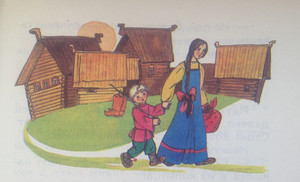
“Sister Alyonushka and Brother Ivanushka” is another Russian folk audio tale about the difficult fate of orphans, about the treachery and malice of envious people. Another theme of the tale is the obedience of young children. How many times has each of us heard, and later himself said, the exclamation: “Don’t drink, brother, you’ll become a little goat!” whenever you have to prohibit something...
In turn, Nitsch recorded several texts from philosophy student Valenti Copchia. Only in the case of post-war respondents presenting Kujawian tales in competitions organized by the Ethnographic Museum in Toruń was more precise information about the storytellers recorded. Felix was a baker by profession, but he worked as a factory worker, and Aldona, who had completed two classes primary school, was a housewife. Patskowski wrote tales he heard from family members, including his uncle Jozef Ziemecki, his sister Kazimira Rucinska, and neighbors, including Maria Neumann.
Audio fairy tale "Khavroshechka". “There are good people in the world, there are worse people, there are also those who are not ashamed of their brother. Tiny Khavroshechka ended up with these. She was left an orphan, these people took her, fed her and overworked her to work: she weaves, she she spins, she cleans up, she is responsible for everything. And her mistress had three daughters..." Misfortune,...
The Russian folk audio fairy tale “Chivy, chivyy, chivychok”, adapted by A. N. Tolstoy, is a fairy tale about irrepressible greed, precedes Pushkin’s “The Tale of the Fisherman and the Fish”, its plot echoes the Bulgarian folk fairy tale “The Good Lark”. The speech in this audio tale is unusually vivid. Storytellers admire the word, admire its sound, its play...
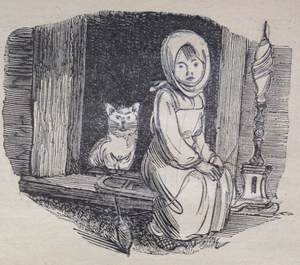
Russian folk audio tale adapted by Alexei Nikolaevich Tolstoy "Crooked Duck" about magical transformations, about witchcraft. The plot is similar to that of the Japanese folk tale "Crane Feathers". The fairy tale teaches kindness, gratitude, hard work, patience, and trust in each other. A kind, good fairy tale for all listeners and for listening...
Russian folk audio tale "Peter 1 and the peasant" about a conversation between the Tsar and a peasant who did not recognize the Tsar. "The king asks: - Is your family big? - I have a family of two sons and two daughters. - Well, your family is not big. Where do you put the money? - And I put the money in three parts: firstly, I pay off the debt , secondly - I give as a loan, thirdly - into the water...
Russian folk audio fairy tale adapted by Alexei Nikolaevich Tolstoy “The Little Thumb” is a fairy tale. It is found in many modifications among East Slavic and Turkic-speaking peoples. Associated with the fairy tales of Charles Perrault and the Brothers Grimm. The Ukrainian folk tale "Shorty" was processed by G. P. Danilevsky. The text of the folk tale of the same name...

Russian folk audio tale adapted by A. N. Tolstoy “The Clay Guy”. Tellers of folk tales admire the word, admire its sound, its play in a fairy tale. In "The Clay Guy" we see repetitions of episodes: this way the thought in fairy tale story. A guy sculpted from clay asks: -Give me, grandma, a little tub of milk and some soft bread...
Russian folk audio tale "Kuzma Skorobogatiy" arranged by Alexei Nikolaevich Tolstoy. Audio tale, traditional for East Slavic folklore. “Kuzma lived and lived alone in a dark forest. He had nothing to throw off or put on, and he didn’t start laying anything. So he set a trap. In the morning he went to look - a fox had fallen......
Russian folk audio fairy tale "The Snow Maiden and the Fox" - arranged by Alexei Nikolaevich Tolstoy. A good, kind audio fairy tale for the youngest listeners with a moralizing overtone. The language of the audio tale is beautiful, melodious and easy to pronounce. "The Snow Maiden and her friends went berry picking. They walked through the forest, picking berries. Tree by tree, bush...
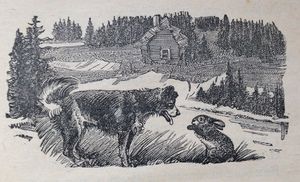
Russian folk audio fairy tale "The Fox and the Hare" arranged by Alexei Nikolaevich Tolstoy - an audio fairy tale about animals about a defenseless bunny, about an insidious and invariably cunning fox, about a brave cockerel. Large animals: a bear, a bull, a dog gave in to the feigned power of the fox, and the courage and prowess of the rooster overcame the fox’s machinations. Here is his inspirational song:...
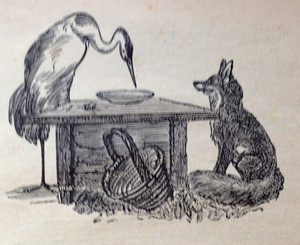
Russian folk audio tale "The Fox and the Crane" arranged by Alexei Nikolaevich Tolstoy. Folklore texts similar to Russian were recorded in Europe, America and Africa; East Slavic variants are few. The written dissemination of the plot originates from Aesop's fable "The Fox and the Crane" as retold by Plutarch. Translated into Latin...
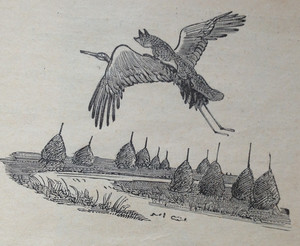
Russian folk audio tale “How the Fox Learned to Fly”, arranged by Alexei Nikolaevich Tolstoy. "A crane met a fox: - What, fox, can you fly? - No. I can’t. - Sit on me, I’ll teach you. The fox sat on the crane. The crane carried her high, high. - What, fox, do you see the earth? - I can barely see: the earth seems like sheepskin! The crane shook it off...

Russian folk audio tale "The Fox and the Crayfish" adapted by A.N. Tolstoy. Several East Slavic and Asian versions of the tale are known. The earliest literary embodiment is in the fables of Aesop “The Tortoise and the Hare”, and the medieval Armenian writer Olompian “The Tortoise and the Horse”. "The fox says to the crayfish: - Let's distill! - Well, fox, come on....

The Russian folk audio fairy tale “The Cockerel is the Golden Comb”, adapted by Alexei Nikolaevich Tolstoy, is one of the first fairy tales that children are introduced to. A kind and at the same time instructive audio fairy tale about animals, where the roles are clearly distributed: a naughty cockerel who always leans out of the window, an evil fox who always wants...
Russian folk audio tale "The Fox and the Black Grouse" adapted by A. N. Tolstoy. Various versions of audio fairy tales are common in a number of countries in Europe and Asia, not only in Slavic folklore. The fox uses cunning to gain the trust of the bird, which is sitting on a tree, and force it to come down closer to the fox. All fairy tales invariably end in flight...

The Russian folk audio fairy tale “The Fox and the Blackbird”, adapted by A. N. Tolstoy, is an audio fairy tale about animals, in which the blackbird taught a lesson to the unscrupulous and insatiable fox, who got into the habit of threatening the blackbird and his family. "A blackbird made a nest on a tree, laid eggs and hatched cubs. The fox found out about this. She came running and tapped her tail on the tree: "The tree with her tail...
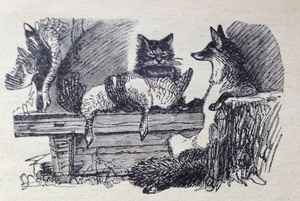
Russian folk audio fairy tale "The Cat and the Fox" arranged by Alexei Nikolaevich Tolstoy - an audio fairy tale about animals, in which the characters very clearly demonstrate the importance of the "cat-voivode"; the cunning of a fox who skillfully builds intrigues; the curiosity and stupidity of the wolf and the bear. Almost the entire audio tale is built on dialogues. The plot, as well as melodious and soft...
Russian folk audio fairy tale "The Bear and the Fox" adapted by A. N. Tolstoy about a cunning fox and a simple-minded and trusting bear, whose fox ate all the honey and blamed it on him. The narrator uses repetition of plot to highlight the idea in the fairy tale; gives the characters a melodious language, gentle intonations, as if tuning both the heroes of the fairy tale and...
Russian folk audio tale "Beasts in the Pit" arranged by Alexei Nikolaevich Tolstoy. Another audio tale about animals, which shows the habits of animals, under whose guise you can trace the characters of people. The chicken was scared of something. Her fear was transmitted to the cockerel, then to the hare, then to the fox, wolf and bear. Everyone ran. "...They ran, they ran, and to...
Russian folk audio tale "Winter quarters of animals" arranged by Alexei Nikolaevich Tolstoy. An audio tale about animals that lead a lifestyle familiar to people. A rooster, a pig, a goose, a ram and a bull fled into the forest from the owner's yard so as not to be slaughtered. "... In the summer it’s free in the forest. The fugitives live - they don’t know grief. But summer has passed, winter has come... Time...
The Russian folk audio fairy tale “The Stupid Wolf”, adapted by Alexei Nikolaevich Tolstoy, is one of the audio fairy tales about animals. The audio tale presents human actions as the actions of animals: a wolf, a foal, a goat. “Once upon a time there was a wolf, an old, old wolf. His teeth were broken, his eyes couldn’t see well. It became hard for the old man to live: at least lie down and die. So...

Russian folk audio tale "Sheep, Fox and Wolf" adapted by A. N. Tolstoy. “One man’s sheep ran away. A fox met it: “Where are you going, little sheep?” Where are you going?" "Oh, little fox-sister! I was with a man, but I didn’t have a life: where the sheep is foolish and mischievous, and it’s all my fault, the sheep! So I decided to go wherever my eyes lead me." "Me too! -...

Russian folk audio tale about animals "The Wolf and the Little Goats" adapted by Alexei Nikolaevich Tolstoy. The narrator repeats the episodes, highlights the thought, admires the word and its sound. “Little goats, kids! Open up, open up! Your mother came and brought milk; Milk runs along the groove, From the groove to the hoof, From the hoof into the cheese earth!”...
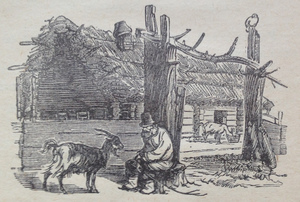
The Russian folk audio fairy tale "The Goat-dereza" adapted by A. N. Tolstoy is one of the most poetic audio fairy tales. "...The old man went out onto the porch and asked: - You goats, you mothers, are you full, are you drunk? The goats answer him: - We are full, we are drunk, We walked through the hills, we nibbled some grass, They ate it, lay under a birch tree! And one goat...

Russian folk audio fairy tale "There is no goat with nuts" arranged by Alexei Nikolaevich Tolstoy - a fairy tale with a chain-like plot. The action flows like a chain from episode to episode. The goat came with tusks, and the goat went for nuts - and she was gone. The goat sends a wolf to the goat, but the wolf does not go to chase the goat. Then the bear is sent to attack the wolf, but the bear doesn’t want to...
Russian folk audio fairy tale in the adaptation of Alexei Nikolaevich Tolstoy "The Hare - Brag". “Once upon a time there lived a hare in the forest: he had a good time in the summer, but a bad time in the winter - he had to go to the peasants’ threshing floor and steal oats. He came to one peasant’s threshing floor, and there was already a herd of hares. So he began to brag to them: “U not my mustache, but my mustache, not my paws, but my paws, not...
Russian folk audio tale adapted by Alexei Nikolaevich Tolstoy "The Tale about the Black Grouse" - a fairy tale about animals. The fairy tale is an assumption about why the black grouse does not “build a house”, about the habits of the black grouse. “Thrown around in the snow! Spent the night in the snow, got up early in the morning, flew around the free world, screamed loudly, loudly... They are with the children in an open field...

Russian folk audio fairy tale adapted by Alexei Nikolaevich Tolstoy “The Bean Seed” is a fairy tale with a chain-like plot. “Once upon a time there was a cockerel and a hen. The cockerel was rummaging and dug up a bean seed. “Ko-ko-ko, hen, eat the bean grain!” “Ko-ko-ko, cockerel, eat it yourself!” The cockerel ate the grain and choked.” The chicken ran to bring some water. A river for some water...
Russian folk audio fairy tale, adapted by Alexei Nikolaevich Tolstoy, “The Kochetok and the Hen” is one of the fairy tales with a chain-like plot. “Once upon a time there lived a hen and Kochetok. They came into the forest to buy nuts. Kochetok climbed up a nut tree to pick nuts, and told the hen to pick them up on the ground. Kochetok threw them, and the hen picked them up. So Kochetok threw a nut and hit the hen in the peephole...

Russian folk audio tale adapted by Alexei Nikolaevich Tolstoy "The Old Man and the Wolf". There are Russian, Belarusian, Ukrainian versions, and Latvian texts of this plot. “The old man and the old woman had a boy and a girl, a cockerel and a hen, five sheep, the sixth was a stallion...” A hungry wolf got into the habit of going to the old man for some cattle. I moved everything. How did it come...
Russian folk audio fairy tale adapted by A. N. Tolstoy “A cat with a gray forehead, a goat and a ram” is a fairy tale about animals. “Once upon a time there lived a goat and a ram in the same yard; they lived together in harmony: a tuft of hay and that one in half. And if a pitchfork hits the side, it’s one cat Vaska! He’s such a thief and a robber, every hour on the hunt, and where something bad lies, His stomach hurts so bad...
Russian folk audio tale adapted by Alexei Nikolaevich Tolstoy "The Crying Fox". The plot is known in all parts of the world. It can be traced from Aesop's fable "The Fox and the Woodcutter", Latin collections of the 18th century and medieval poems. “Once upon a time there was an old man and an old woman. The old woman died. The old man felt sorry for the old woman. He went to look for him crying...” They met him...

Russian folk audio tale "The Man and the Bear" adapted by Alexei Nikolaevich Tolstoy about how a man and a bear sowed turnips, and another year rye, and then divided the tops and roots. The bear, inexperienced in agricultural work, always chose the tasteless part of what was grown. "He got angry with the man, and since then the bear and the man have been at enmity...
Russian folk audio fairy tale adapted by Alexei Nikolaevich Tolstoy “Hares and Frogs” - a small fairy tale about animals, about the rank of hares among animals, about the habits of frogs. “Once the hares came together and began to cry for their lives: “We die from people, and from dogs, and from eagles, and from other animals. It’s better to die than to live and suffer in fear, let’s...
Russian folk audio tale "Bear - Lime Leg". The plot is typical for Russian, Ukrainian, Belarusian, Latvian folklore. This version of the fairy tale, as adapted by Alexei Nikolaevich Tolstoy, is quite harsh; this fairy tale cannot be called good. The characters alternate their blows to each other, and each subsequent move is inadequate...
Russian folk tale adapted by Alexei Nikolaevich Tolstoy “How the old woman found a bast shoe” about a completely unscrupulous old woman who enriched herself by deceiving good people. The negative attitude of the people towards this kind of enrichment follows from the ending of the fairy tale, when everything acquired by deception is lost, and the old woman is left with nothing. To listen online...
Russian folk audio fairy tale, adapted by A. N. Tolstoy, that man is stronger than all animals, because he is more cunning than animals, birds and fish and owns different weapons. "...The lion went to look for a man. A boy comes towards him. “Are you a man?” “No, I’m not a man yet.” I'm a boy. When will I be a man!" The lion did not touch him, walked past him. He walked towards him...
Russian folk audio tale "War of the Mushrooms". In ancient times, King Pea fought with mushrooms. A boletus mushroom, a colonel sitting above the mushrooms, sitting under an oak tree, looking at all the mushrooms, began to order: “Come, you little whites, to my war!” The white women refused: “We are pillar noblewomen! We will not go to war!” "Come, saffron milk caps, to my...
The Russian folk audio fairy tale "Mizgir" belongs to the genre of fairy tales about animals. It tells about the evil misgir spider, which began to “... shake its legs and weave hems, place it on the path, on the path where mosquitoes and midges fly...” He then released the fly, which “will have many orphans left.” ", but he did not spare other mosquitoes and midges. "They...
Audio fairy tale "Teremok" for the youngest listeners. A Russian folk tale with a chain-like plot, processed by A.N. Afanasyev, V.I. Dahl, D.K. Ushinsky, Yakub Kolas, S.Ya. Marshak. We offer you to listen online or download to your audio library the audio fairy tale “Teremok” for the youngest children at night.
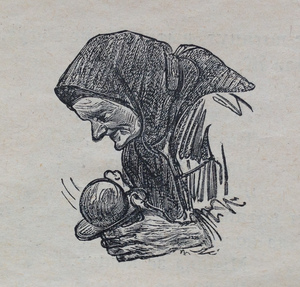
Russian folk audio tale "Kolobok" arranged by A.N. Tolstoy is a fairy tale with a chain-like plot. From one event the next follows. The journey of the kolobok from the hut to the hare, from the hare to the wolf, from the wolf to the bear, from the bear to the fox is accompanied by the beautiful kolobok song: “I am the kolobok, I am the kolobok, I am scraping the box, sweeping the bottom of the barrel, on sour cream...

Russian folk audio fairy tale adapted by Alexei Tolstoy "Turnip" - a fairy tale with a chain-like plot. The action moves from episode to episode, leading to the final event. The idea behind this composition is that every creature has an important role to play. A little mouse can help in a big way. The audio fairy tale "Turnip" is intended to be listened to online, or "Turnip"...
Russian folk audio fairy tale adapted by A.N. Tolstoy about Emelya “At the Pike’s Command” for listening to children from a young age. “According to the pike's command” is a version of a well-known Russian fairy tale. Numerous East Slavic versions of the plot are known. Varieties have been recorded in Europe, Asia (Türkiye) and America. Literary...
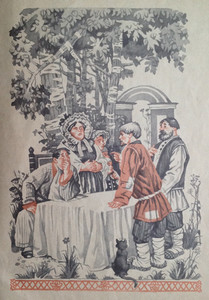
Russian folk audio fairy tale “How a man divided the geese”, adapted by Alexei Nikolaevich Tolstoy, about a quick-witted, savvy, cheerful man who, with his quick mind, earned the gratitude of the master and got hold of money, bread, and was also left with roast geese. The storyteller's sympathy is on the side of the poor man, against the envious rich man...
FAIRY TALE one of the types of folklore prose, found among various peoples and subdivided, in turn, into genres. Since a unified scientific classification still does not exist, researchers identify genres or groups of fairy tales in different ways. So E.V. Pomerantseva divides them into tales 1) about animals, 2) magical, 3) adventure-novelistic and 4) everyday, while V.Ya. Propp divides fairy tales into 1) magical, 2) cumulative, 3 ) about animals, plants, inanimate nature and objects, 4) everyday or novelistic, 5) fables, 6) boring fairy tales.The most important characteristic of a fairy tale is that it contains an obligatory focus on fiction, which also determines the poetics of the fairy tale. The main features of a fairy tale, according to V.Ya. Propp, include “inconsistency with the surrounding reality” and “extraordinary... events that are narrated” (this is the difference between a fairy tale and a literary narrative).
Fairy tale genres. Fairy tales, as emphasized by V.Ya. Propp (whose classification is used in this section), “are distinguished not by their magic or miraculousness... but by their completely clear composition.” At the heart of a fairy tale (an idea that a variety of researchers have come to, independently of each other) is the image of initiation (initiation is a type of rite of passage, the initiation of young men into the ranks of adult men) hence the “other kingdom” where the hero must go in order to acquire bride or fabulous values, after which he must return home. The narrative is “taken entirely outside the real life». Characteristics fairy tale: verbal ornament, sayings, endings, stable formulas.Cumulative tales are built on the repeated repetition of some element, as a result of which either a “pile up” ( Tower of flies), or "chain" ( turnip), or “a successive series of meetings” ( Kolobok) or “references” ( The cockerel choked). There are few cumulative tales in Russian folklore. In addition to the compositional features, they are distinguished by style, richness of language, often gravitating towards rhyme and rhythm.
The rest of the tales are distinguished into special genres not on the basis of composition, which has not yet been sufficiently studied, but on other grounds, in particular, on the character characters. In addition, in non-magical fairy tales, the “extraordinary” or “wonderful” “is not taken outside the boundaries of reality, but is shown against the background of it. In this way, the unusualness takes on a comic character.” The supernatural (wonderful objects, circumstances) is absent here, and if it does occur, it is comically colored.
Tales about animals, plants (war of mushrooms, etc.), about inanimate nature (wind, frost, sun) and objects (bast shoe, straw, bubble, coal) make up a small part of Russian and Western European fairy tales, while among the peoples of the North, North American and African tales about animals are widespread (the most popular heroes are dexterous
trickster deceivers (clowns) hare, spider, fox, coyote).Everyday (novelistic) fairy tales are divided by types of characters (about clever and clever guessers, about wise advisers, about clever thieves, about evil wives, etc.).
Fables tell “about completely impossible events in life” (for example, about how wolves, having driven a person into a tree, stand on each other’s backs to get him out of there).
Boring fairy tales, according to V.Ya. Propp, are rather “jokes or nursery rhymes” with the help of which they want to calm down children who demand to tell fairy tales ( About the white bull
). The variety of folk tales in this classification is by no means exhausted; for example, in the Slavic tradition, tales of heroes, soldiers, etc. can also be distinguished.The existence of a fairy tale. Folk tales were performed by special storytellers and storytellers. The same fairy tale in the mouths of the performers could be transformed both for subjective reasons (the preferences of the storyteller himself, his talent) and for objective reasons, for example, depending on the nature of the audience.The written narrative tradition has had a significant influence on folk tales. Collection Panchatantra, which united Indian parables and fables, was adopted by the literature of different peoples through translations and borrowings. The collection of oriental tales has a similar fate. Thousand and One Nights, first translated into French, and then from French into the languages of the peoples of Europe. The Russian fairy tale tradition was influenced by both translated literature (parables, knightly novels, etc.) and popular literature. All this, in turn, enriched the oral tradition.
Collection and scientific study of fairy tales. The science of fairy tales became an independent discipline in the 19th and 20th centuries. Its formation is not associated with any one scientific school; scientists from various scientific fields made their contribution.Mythological school. The main position defended by the mythological school is that the similarity of plots is determined by a common “proto-myth” inherited by different peoples from a single ancestor.The brightest representatives of the school were the German philologists and folklorists brothers Jacob Grimm (1785-1863) and Wilhelm Grimm (1786-1859). see also GRIMM, JACOB AND WILHELM. Authors of interesting scientific works, including Germanic heroic tales(1829), they became famous, first of all, for the publication of German folklore legends (1816-1818) and fairy tales that appeared a little earlier. Book Children's and family fairy tales, published in separate issues from 1812 to 1814, not only presented the monuments of German folk literature to the public with great completeness (the last lifetime edition includes 210 fairy tales), the attitude of folklorists to the material determined the approach to folk tales of other researchers.
The Brothers Grimm strived for accuracy, preserving, whenever possible, features characteristic of oral storytelling. Their collection is distinguished by clarity and simplicity; the notes give variations of the plot and parallels drawn from the folklore of various European peoples. The edition they prepared is not free from weaknesses: the sequence of fairy tales is random, the most typical fairy tales were chosen for publication, which prevented the material from being presented in all its diversity, in addition, the language and style of the published texts were edited, which is especially noticeable now that the so-called Elenberg manuscript has been published , where the texts are given without editing.
Among the followers of the mythological school are major domestic philologists F.I. Buslaev (1818–1897) and A.N. Afanasyev.
Alexander Nikolaevich Afanasyev (18261871), historian and literary critic, author of a fundamental three-volume study Poetic views of the Slavs on nature(18661869), played an outstanding role in the collection and publication of Russian fairy tale heritage. Collection Russian folk tales(originally published in eight separate issues from 1855 to 1864) remains unsurpassed to this day.
Speaking about the most important task of collecting and publishing “folk tales” (which, in his words, “are the essence of the fragments of the most ancient poetic word epic,” and therefore have preserved many signs of the past), A. N. Afanasyev notes not only the aesthetic and scientific merits of such a collection , but also its significance in business
raising children subject to strict selection of fairy tales.The collection is compiled from various sources. Russian geographical society, of which Afanasyev was a member, placed at his disposal materials on fairy tales from its rich archive. P.V. Kireevsky (1808-1856) handed over to the compiler the notes he kept, made by P.I. Yakushkin (
18221872 ), a famous collector folk songs, V.I. Dal(18011872 ), who focused on publishing Russian proverbs and sayings, handed over his own notes (before that, he published some fairy tales, having previously processed them). In addition, texts borrowed from periodicals and popular prints of the 18th and 19th centuries were included. A.N. Afanasyev himself wrote down a little more than a dozen fairy tales, but he did not intend to act as a folklorist. He set himself the task of classifying and publishing the accumulated materials, and he coped with it excellently. Russian folk tales, including about 600 texts, is not only the largest collection of its kind. Starting from the second edition, A.N. Afanasyev introduced a classification of fairy tales. He also published the options he had available.Unfortunately, it is impossible to compensate for the different approach to the material in the primary sources; there are both retellings and exact recordings (in some cases the local pronunciation is preserved); not all texts are provided with an indication of where they were recorded. But the compiler treated the texts with care; editorial changes on his part were rare and insignificant. Also excluded from the collection, in the words of A.N. Afanasyev himself, was “everything that was crippled” by censorship. Censorship bans affected texts that had a strong social (often anticlerical) orientation, and texts whose appearance in print was excluded for moral reasons (explicit language, erotic stories, sometimes “with pictures,” sexual symbolism).
A truncated version of this part of the Afanasiev collection was published around 1872 in Geneva under the title Russian folk tales are not for publication. The first scientific publication was published only in
1997 . Among the “treasured fairy tales” (the definition adopted in the scientific literature) there are less than a dozen fairy tales about animals, not much more fairy tales (it is characteristic that in the tradition the same fairy tales coexist with and without erotic details), the vast majority are fairy tales householdComparativist (migration) school. Its adherents developed the idea that similarities in the works of Eurasian peoples, not necessarily related, arose either through borrowing or as a result of a common source. The migration and development over time of literary and folklore images, motifs and plots were mainly studied. Among the representatives of the school is the German philologist T. Benfey ( 18091881 ), Czech philologist J. Polivka ( 18581933 ), Finnish folklorist A. Aarne ( 18671925 ). In Russian literary criticism, the ideas underlying the comparative theory arose independently. The largest representative of comparative studies in Russia philologist A.N. Veselovsky ( 18381906). English "anthropological school". Followers of this school argued that the similarity of fairy-tale plots is dictated by their spontaneous generation on a common everyday and psychological basis. The most famous representatives of the school are the English ethnographer E. Taylor ( 18321917 ), Scottish writer E. Lang ( 18441912). Structural approach. The most important role in the study of the fairy tale was played by the Russian scientist Vladimir Yakovlevich Propp (1895-1970). He demonstrates his approach in the book Morphology of a fairy tale(1928) using the example of a fairy tale. He considers a fairy tale as a single structure in which there are constant and stable elements, functions, and these functions do not depend on how and who performs them, the number of functions is limited, the sequence is unchanged.Functions there are 31 in total, and not all of them are necessarily present in every fairy tale, absence, prohibition, violation of the prohibition, villain (negative character), complicity (the villain deceives the hero, who unwittingly becomes his accomplice), misfortune, misfortune (flaw), active opposition , hero leaving home, helper (giver), magical remedy, battle with the enemy, wounding of the hero, defeated enemy
, eliminating the shortage (trouble), returning home, false hero, punishment of the false hero, transformation (recognition of the true hero and receiving a new status), marriage, accession to the throne.In a fairy tale, according to V.Ya. Propp, there are seven types of characters: villain, helper, donor, seeker, messenger, hero and false hero. In the absence of some characters, his functions are transferred to the hero himself. In addition to dividing into genres (fairy tales, cumulative tales, etc.), he proposed a further division into types, which, in turn, break down into plots, which break down into versions and variants.
The structural approach to the material was supplemented and partly rethought in the book Historical roots of fairy tales(1946). The author considers the initiation rite as the general basis of the fairy tale structure (we are again talking about a fairy tale). These scientific positions were partly anticipated in the book Perrault's tales and parallel stories(1923) by the French researcher P. Sentiv, which does not detract from the importance of the book by V.Ya. Propp.
An original approach to the material was proposed in the monograph by E. Meletinsky, D. Segal, E. Novik Fairy tale structure
(1999). Systematization of fairy tale material. The work of the Finnish scientist A. Aarne played a huge role in the study and systematization of fairy tales Index of fairy tale types (1910 ). The index is based on the material of European fairy tales; the fairy tales themselves are divided into 1) tales about animals, 2) fairy tales, 3) legendary, 4) novelistic, 5) tales about a fooled devil and 6) anecdotes.Important clarifications to Aarne’s work were made by the American scientist S. Thompson, who created Index of fairy tales(1928). Soviet folklorist N.P. Andreev (
18921942 ), who translated Aarne's index into Russian, revised it, adding tales from the Russian fairy-tale repertoire. Book Index of fairy tales according to the Aarne system(1929) has not lost its significance. Half a century later, the work of L.G. Barag, I.P. Berezovsky, K.P. Kabashnikov, N.V. Novikov appeared Comparative Plot Index(1979), dedicated to East Slavic fairy tales.The International Federation of Folklorists (Helsinki), founded in 1910, does a lot to study and systematize fairy tales, regularly publishing indexes and monographs. In addition, the international magazine Fabula (Göttingen), published since 1957, plays an important role in international folkloristics.
and published since 1975 in English and German languages Encyclopedia of Fairy Tales(Berlin, New York).Interpretation of fairy tale material. A significant role, if not in the study of fairy tales as a phenomenon of folklore, then in cultural studies and self-awareness modern culture play scientific works in psychology, interpreting fairy tale material for their own purposes.Sigmund Freud
(18561939 ), Austrian psychologist, neuropathologist and psychiatrist, creator of “psychoanalysis”. Based on Freudian theory, his follower O. Rank considered the fairy tale (which, according to him, appeared during the period of streamlining family and clan relations) as veiling the sexual complex, as opposed to myth, where the complex is presented openly.Carl Gustav Jung
(18751961 ), a Swiss psychiatrist, the founder of “analytical psychology,” unlike S. Freud, studied not sexual complexes and their repression, but the psychology of the unconscious. According to him, there are two layers in the subconscious - personal, and collective, deeper, which develop not individually, but are inherited. The depths of the collective subconscious store not complexes, but archetypes, elements of mental structures that the scientist compared with fairy-tale and mythical images and motifs.Erich Fromm
(19001980 ), American philosopher and cultural scientist, converter of Freudianism, in progress Forgotten language (1951 ) considered the language of symbols, drawing on dreams, myth and fairy tales for research.A literary fairy tale and an author's fairy tale. Analyzing the attitude to reality in folk tales and literature, V.Ya. Propp draws a clear line between the forms of thinking typical of folklore and the forms of thinking that determine literary creativity (in the original source we are talking about 19 century, but the pattern extends to the 20th century), and the laws underlying the poetics of folklore and the poetics of literature also differ. V.Ya. Propp does not deny that literature and folklore are connected: “The process of transition of plots or narrative style into literature was accomplished... not by borrowing only, but and this is most important by overcoming the attitude to reality that is characteristic of fairy-tale narrative folklore " This is where the differences between an author's and literary fairy tale and a folk fairy tale begin.The “mechanics” of transferring text from folklore into literature is also important. If a folk tale exists exclusively in oral tradition, then it is logical to conclude that with the most careful transfer to paper, it loses some of its properties, acquiring properties that are not inherent to it. The conditional division of the text during recording, and the very principle of “fixing” the text, while during oral performance the same fairy tale is conveyed a little differently each time, forces us to talk about the emergence of a literary fairy tale, that is, subjected to processing, even in the case when the original the text is a fairy tale
folk This is the basis of the well-known incident with A.M. Remizov, who was accused of plagiarism after the publication of a folk tale he had processed The sky has fallen. The victim noted that if we compare his text with the folklore recording made by M.M. Prishvin, there are few differences, but he, in his words, “gave the narrator his tongue,” using syntax, clarified the intonation, and added expressiveness. It is also characteristic that, especially at the early stage of recording folklore texts, the invasion of folklorists themselves, their “ennoblement” of a folk tale, its “smoothing” led away from the folklore source.The next stage in the written existence of a fairy tale is the author's fairy tale. It is not always distinguished from a literary fairy tale (sometimes both words act as synonyms), which is incorrect. The author's fairy tale is characterized by an increased degree of psychologism, the transformation of characters from “signs” into full-blooded “images,” and often an emphasized play with fairy-tale clichés (the latter is especially important for 20th-century literature).
The author's fairy tale is also distinguished by its “double existence.” With rare exceptions (in cases where the work is intended exclusively for a children's audience), the author's fairy tale has several levels of reading, and therefore can be perceived differently by adults and children. Moreover, it does not matter which reader the fairy tale is addressed to, as evidenced by two equivalent processes: the transformation of “adult” books into “children’s” (C. Perrault
, R.R. Tolkien) and the reverse movement from a “children’s” book to an “adult” one (L. Carroll). It should be noted that the boundary between a literary fairy tale and an author's fairy tale is fluid. Often the processing of folk tales turns them completely into author's tales. It should also be remembered that the principle of processing depends not only on the author’s intention, but also on what audience the text is intended for. In this sense, it is necessary to consider various adaptations of a fairy tale for a poorly prepared reader (listener) as a purely service approach, without fitting them into either the folklore or literary context.Masters of the author's fairy tale. The ancestor of the author's fairy tale can be considered the French poet and critic Charles Perrault (Perrault, 16281703). To the collection Tales of My Mother Goose, or Stories and Tales of Old Times with Lessons, which was published in 1697 and was signed not by the name of Perrault himself, but by the name of his son Darmancourt, 8 fairy tales were included (when reprinting the book, the author included 3 more poetic fairy tales), each fairy tale contained a moral in verse. The style of these works brought them closer to court literature.The Italian playwright influenced the tradition of the author's fairy tale Carlo Gozzi(1720-1806), whose plays combined motifs borrowed from Italian folklore and motifs from oriental fairy tales, but transformed by the imagination of the writer and the influence of commedia dell'arte, the poetics that the author used. Among the dozen fairy tales written by Gozzi, Love for Three Oranges
(1761), The Stag King (1762) and Turandot(1762), imbued with a kind of fairy-tale psychologism, distinguished by the sharpness of collisions and the accuracy of the characters’ characteristics.One of the best masters The author of the German fairy tale was the prose writer Wilhelm Hauff (Hauff, 18021827). A peculiar combination of oriental motifs with motifs of national folklore marks his Fairy tales for the sons and daughters of the educated classes(18261828). The works that the author composed for adults have become classic children's reading.
The tales of the Danish prose writer Hans Christian Andersen (Andersen, 1805-1875) are addressed to an audience, regardless of age. In his books Tales told to children
(1835), New Tales (18441848), Stories (18521855), New fairy tales and stories (1858-1872) combine fairy tales of different origins (from those heard in childhood to those written on plots borrowed from Italian folk songs, the poetry of Anacreon, etc.).Italian writer Carlo Collodi ( real name Lorenzini,
18261890 ) created a classic fairy tale The Adventures of Pinocchio. History of the puppet (188 0 ). Behind the adventures of the wooden doll, attentive readers discerned a background and, on this basis, interpreted the fairy-tale episodes as a gospel plot (the carpenter father, the last supper in the Red Crayfish tavern).A unique situation has arisen in English literature, where a whole school of author's fairy tales was formed. Played an important role character traits English prose, including ironic narration, humor bordering on the absurd. English authors in many ways anticipated later genre discoveries. It is also important that many English literary fairy tales were initially told to a small circle of listeners (the details and plot twists may have been incomprehensible to outsiders), and only later were transferred to paper.
Literary critic N. Demurova notes: “Ruskin, Kingsley and Macdonald use the “morphology” of fairy tales, adapting the morphology of English and German folklore to construct their own fairy tale narratives, designed in Christian and ethical tones, generally not going beyond the limits of reductions and replacements allowed by the structure of folk tales and assimilation. Confessional and superstitious substitutions play a special role among them. Dickens and Thackeray create in their fairy tales an organic fusion that is very different in spirit, in which the element of parody (and sometimes self-parody) is extremely strong. Ironically rethinking the characteristic themes of their own realistic creativity, romantic fairy-tale motifs and techniques, they move far away from the strict structure of a folk tale, preserving only some of its moves and characteristics.”
William Makepeace Thackeray (Thackeray, 1811-1863), rejecting didacticism and ridiculing the pedagogical pomposity that permeates the works of secondary and tertiary writers, created fairy tales, in a certain sense “anti-fairy tales”, destroying the established canons, altering the usual plot schemes. In this case, material was also borrowed for example, a fairy tale Sultan Stork(1842), an ironic variation based on the fairy tale by V. Gauf, and a completely original fairy tale Ring and rose
(1855). Charles Dickens (1812-1870) paid tribute to the author’s tale; it’s worth mentioning at least Magic bone » ( A novel written during the holidays, 1868). Books have become classics King of the Golden River(1841, first edition 1851) by John Ruskin (Ruskin, 18191900) and Children of the water(1863) by Charles Kingsley (Kingsley, 18191875).George MacDonald (1824-1905) played a huge role in the history of English fairy tales. The sentimental intonation that colors the narrative pays off by being entertaining, while the relationships of the heroes with folklore characters are like in a fairy tale The Princess and the Goblin(1872) fit within the framework of literary rather than oral tradition. Among other works fairy tales Princess and Kurdi
(1877), The Golden Key (1867) and originally included in the novel Adela Cathcart fairy tales Weightless Princess(1864) and Giant's Heart(1864), subsequently published separately. Mystical motifs occupy a prominent place in D. MacDonald's prose. His books influenced, by their own admission, G. K. Chesterton, C.S. Lewis and R.R. Tolkien. L. Carroll, who was friends with the children of D. MacDonald, also took his experience into account.Origin of the tale Alice in Wonderland(1865) by Lewis Carroll (Carroll, real name Charles Lutwidge Dodgson, 18321898) is indicative. The fairy tale was composed at the request of the little Liddell sisters, and it had the features of oral improvisation: ill-conceived composition, relying not on a precisely chosen word, but on intonation
. Again, at the request of the listeners, the fairy tale was recorded, receiving the name Alice's Adventures Underground(1863), and subsequently edited. After success Alice in Wonderland And Through the mirror and what Alice saw there, or Alice through the looking glass (187 1) were published and facsimiles Alice's Adventures Underground And Alice for children, which confirmed the idea of the diversity of fairy tales. This is where numerous interpretations of L. Carroll’s works originate, including psychoanalytic and mathematical ones. Topsy-Turvy, or A Lesson for Fathers (1882) F. Anstey (real name Thomas Anstey Guthrie, 18561934) is a typical inversion used in both folk poetry and theatrical farces. The reason why the heroes of the story, father and son, swapped places is atypical. Plot of the story Copper jug(1900) adapted from the book Thousand and One Nights . The story, which later became known as Wind in the willows(1908), was composed by Kenneth Grahame (1859-1932) for his son, so oral stories formed its basis. Characters quite suitable for fairy tales about animals, Rat, Mole, Badger, Toad, and appearance, and their behavior resembles English gentlemen, and the adventures that befell them are completely in the literary tradition.James Matthew Barrie (Barrie, 1860-1937) came up with the story on which the story is based Peter Pan and Wendy(1911), for the children of his close friends. Growing out of an oral story, this story was embodied in both prose and drama; there is a play of the same name.
Rudyard Kipling (Kipling, 1865–1936) used in his prose knowledge not only of his native folklore, but also of world mythology. Mythological motifs and reminiscences are distinguishable in The Jungle Book(1894) and The second jungle book(1895). In the collection That's how fairy tales are(1902) combines stories that were initially told to the daughter. It would be more accurate to call them not fairy tales, but etiological stories (a folklore genre that offers listeners an explanation of certain cultural situations, the history of the origin of things and rules of behavior). A fairy tale constructed according to such laws can be found in The Jungle Book
( How did Fear come? In collections Puck from the Puka Hills(1906) and Awards and fairies(1910) are present and fairy tale characters, and historical personalities. The author wanted to show the continuity of human history.It is worth at least mentioning other masters of the author's fairy tale - these are Walter de la Mare (de la Mare, 1873-1956), Elinor Farjeon (Farjeon, 1881-1965), Alan Alexander Milne (Milne, 1882-1956), Pamela Lyndon Travers ( Travers, real name Helen Lyndon Goff, 1899 or 19061996). This genre continues to develop in English literature.
18581940 ) created a classic children's book Nils Holgerson's wonderful journey through Sweden (19061907 ). Another Swedish writer, Astrid Lindgren (Lindgren, 1907-2003) began writing fairy tales after World War II. Her books, albeit indirectly, reflected the changes that Western society has undergone: behavioral stereotypes have become different, social norms are less strict, and therefore, even a few years earlier, books such as Pippi Longstocking(19451946) or The Kid and Carlson, who lives on the roof(19551968), would not have seen the light of day.The Italian prose writer Gianni Rodari (1920-1980) is associated both with the tradition of folk tales and with the literary tradition, which is reflected in fairy tales The Adventures of Cipollino(1951) and Journey of the Blue Arrow(1952), and also in the book Tales on the phone(1962). The storyteller summarized his experience in the book
The Grammar of Fantasy (1973), a kind of self-instruction manual for those who want to try composing. He actively uses various literary works, including the works of representatives of the Russian formal school V.B. Shklovsky, etc.Book Tim Thaler, or Sold Laughter(1962) by German prose writer and poet James Crews (1926
1999 ) is a striking example of the fact that a “children’s” book can be read in different levels. The recent attempt to compile a dictionary of magic and sorcery as a tool for interpreting this text by J. Cross-Tink is interesting and fruitful.Fairy tale in Russian and Soviet culture. To understand how special a place the fairy tale occupied in Russian culture, and the significant role it played, we should remember that in Ancient Rus' was absent fiction. This situation was created due to the fact that literature did not have an entertainment function; the issues raised by it were political, historical, and religious issues. Reading brought “benefit”, not “pleasure”. But, as V.Ya. Propp pointed out, “the fairy tale... is the main genre of folk prose, pursuing strictly aesthetic goals.” Although other genres objectively have aesthetic functions, the narrator has a different goal in mind (tradition introduces the past, legend offers moral teaching, etc.).The circle of “unuseful reading” developed only in the 17th–18th centuries. Among the “stories” and “stories”, short-story tales, including “fairy tales not for publication,” occupy an important place. In a certain sense, this tendency made itself felt in the 19th century, when Russian literary and author's fairy tales began to take shape.
Vasily Andreevich Zhukovsky
(17831852 ) became one of the founders of the Russian fairy tale. It is curious that, writing in 1831 tales of the Sleeping Princess and Tsar Berendey, he entered into creative competition with A.S. Pushkin, who developed similar plots.Among the fairy tales of A.S. Pushkin (
17991837 ), at least two are associated with “treasured” fairy tales this is an openly frivolous fairy tale Tsar Nikita(1822) and anticlerical The Tale of the Priest and his Worker Balda(1831), the plot of which was recorded by the author along with other fairy tales he heard. Pushkin's fairy tales reflected familiarity with a variety of texts, from folk tales from the collection of the Brothers Grimm to high literature, motifs and whole storylines from which they learned the short story by the American prose writer Washington Irving (17831859) suggested some plot moves Tales of the Golden Cockerel(1834). The author’s acquaintance with Russian folklore also had an undoubted influence on Pushkin’s fairy tales plot Tales of dead princess and about the seven heroes(1833) was popular among peasants, as well as the theme Tales of Tsar Saltan(1831), in the latter the influence of popular literature is also noticeable.One of the best Russian fairy tales Black chicken, or Underground inhabitants. Magic story for children(1829) written by Antony Pogorelsky (real name and surname Alexey Alekseevich Perovsky, 17871836). The title of the fairy tale and some motifs reflect the author’s familiarity with esoteric literature (on the basis of this the second plan of the fairy tale is built, of course, not intended for a children’s audience).
A significant role in the development of Russian literary and author's fairy tales was played by Vladimir Ivanovich Dal with his variations on the themes of Russian folklore fairy tales, Pyotr Pavlovich Ershov (
18151869 ), author of a poetic tale The Little Humpbacked Horse (1834 ), Mikhail Evgrafovich Saltykov-Shchedrin(18621889 ), creator of numerous satirical tales.A special place is occupied by the work of N.P. Wagner (1829–1907). Tales of the Cat Purr(first edition 1872), a collection of various fairy tales, some of which were written under the obvious influence of H.H. Andersen, also includes absolutely independent fairy tales. They were so popular that
1872 to 1913 the book went through nine editions.The fact that the Soviet author's fairy tale took off as a genre is a huge merit Korney Ivanovich Chukovsky(real name and surname Nikolai Vasilyevich Korneychukov, 18821969). Having begun to compose poetic fairy tales even before the revolution the first experience of this kind fairy tale Crocodile(1916), improvised for his son. He created a number of fairy tales that have become classics Moidodyr
(1923), Cockroach (1923), The clattering fly (1924), Barmaley (1925), Aibolit (1929). K.I. Chukovsky defended the right of fairy tales to exist in the years when a purposeful struggle was waged against them: fairy tales were considered unnecessary, and even harmful reading, developing empty daydreaming in children.An interesting experience in creating an author's fairy tale in line with the folk oral tradition was carried out by Boris Viktorovich Shergin (1896–1973), who had an excellent knowledge of northern folklore, who wrote down fairy tales from his school days and published several books of original fairy tales (the first Near the Arkhangelsk city, at the ship's shelter, 1924), and Stepan Grigorievich Pisakhov (18791960), creator of the cycle Northern Munchausen, told from the perspective of a Pomeranian peasant, whose first book Don't like don't listen(1924) was published simultaneously with Shergin’s book.
(18991960) Three Fat Men (1924, published 1928), his only experience in children's literature. The author was influenced by a variety of sources, from the prose of Western European writers to the performance of S. M. Eisenstein Simplicity is enough for every wise man, nevertheless, the fairy tale is absolutely original and represents, probably, the first, and unusually successful, experience of a revolutionary fairy tale (the heroes overthrow the yoke of the Three Fat Men and free the people languishing under the yoke of rulers, evil loafers and parasites).Creation Evgeniy Lvovich Schwartz (1896-1958) demonstrates the “mechanism” of creating an author’s fairy tale. If in his first plays, such as Underwood(1929), fairy-tale motifs occupy a modest place, then subsequently the fairy tale grows to the volume of the entire work, while plots borrowed from H.H. Andersen Naked King
(1934), The Snow Queen (1939), Shadow (1940) transformed by Schwartz's imagination, they become absolutely independent. Later plays, e.g. The Dragon(1944) and An ordinary miracle(1954), demonstrate an excellent knowledge of Western European fairy tales, but are an integral part art world playwright.The book was a success Alexey Nikolaevich Tolstoy
(18831945) The Golden Key, or The Adventures of Pinocchio (1936). He first addressed this topic in 1924, when his retelling of Carlo Collodi’s book about the adventures of Pinocchio was published. However, the book, which tells about the adventures of the wooden boy Pinocchio, is far from the Italian source, it is original in plot, and its hero is more charming than the hero of the Italian fairy tale. This book, in a certain sense, is a pamphlet that reflects the culture perfectly familiar to the author “ silver age" A hint that there are several plans here is given in the author’s designation of the genre “ new novel for children and adults,” but the genre is not indicated in the printed text. A.N. Tolstoy also approached retellings of folk tales in his own way. In the fairy-tale collection he planned in five volumes, he, as the critic noted, enriches the “root” version of the fairy tale at the expense of other variants. Due to various circumstances, only the first volume (1941) saw the light of day.Lazar Ilyich Lagin (real name Ginzburg, 19031979), creating a story Old Man Hottabych(1938), also focused on a foreign model. However, the book by F. Anstey Copper jug was just the source of the plot, the author is building a different narrative, in his opinion, fairy-tale magic in a socialist country that has achieved considerable success and, most importantly, developed a new type of person, is not entirely appropriate, it is not for nothing that the genie Hassan Abdurrahman ibn Hottab in the end tries to participate in building a socialist society.
Alexander Melentyevich Volkov (1891–1977) also began by retelling someone else’s book. Tale The Wizard of Oz(first edition 1939) is directly related to the book of the American writer L.F. Baum (18561919) The Wise Man of Oz(first edition 1900). Subsequently released Oorfene Deuce and his wooden soldiers
, Seven Underground Kings, Fire god of the Marrans, Yellow fog and The Mystery of the Abandoned Castle original compositions.The work of Tamara Grigorievna Gabbe (1903–1960) also includes “variations on a theme” and original works. The processing and retelling of fairy tales written by Western European prose writers became, on the one hand, a literary school, and on the other, a source of plots and details used by the playwright in his own works, therefore plays The City of Craftsmen, or The Tale of the Two Hunchbacks"(1943) and Tin rings(another name Almanzor's Magic Rings, 1960) form a complex whole, characterized by recognizable motifs, regrouped and inscribed in the original work.
18991951 ). Russian folk tales have been transformed so much that it is hardly correct to call it “processing.”By the 50s, the genre designation “fairy tale” or “fairy tale” became commonplace. fairy tale”, in fact, is not a completely accurate substitution for the concept of “author’s fairy tale”.
The books of Vitaly Georgievich Gubarev (1912–1981) become famous. Kingdom of Crooked Mirrors
(1951), In the Far Far Away Kingdom (1956), Three on an Island (1959). The first of them made an unsuccessful attempt to create a “revolutionary fairy tale.” The book's true popularity came from the film of the same name directed by A.A. Rowe, released in 1963.Using the example of the trilogy of Nikolai Nikolaevich Nosov (19081976) The Adventures of Dunno and His Friends (separate edition 1954), Dunno in Sunny City(separate edition 1958) and Dunno on the Moon(separate edition 1971) it is not difficult to see that the genre of the author's fairy tale can accommodate any structural formation, from utopia to pamphlet.
Valery Vladimirovich Medvedev (born 1923) in the story Barankin, be human!(1962) is close to the science fiction genre.
The Leningrad school of author's fairy tales should be highlighted. The leading place in it was occupied by Radiy Petrovich Pogodin (1925-1993), the author of books designed for different age audiences. If the story Step off the roof(1968) is addressed to teenagers, then A book about Grishka. The story about the axle and the nut that is inside(1974) and About the foal Misha and the mouse Terenty(1978) were written for younger schoolchildren.
A curious trend - the movement from the author's own fairy tale to a rather literary fairy tale - is demonstrated by the stories of Eduard Nikolaevich Uspensky (b. 1937). In the book Crocodile Gena and his friends(1966) he creates an unusual system of characters, making the main character a creature he invented, a book Down the magic river(1979) is built on a play with the clichés and stereotypes of a folk tale, which seems to emphasize the way the source material is processed (in this case, reduced) folklore work, acquiring the features of an author's fairy tale.
Fairy tale in literature and art. Fairy tales, both folk and author's, are actively used in other forms of art. In this case, the fairy tale is used both as a genre and as source material (not necessarily processed according to fairy tale canons).Entered the treasury visual arts illustrations for the fairy tales of Charles Perrault by the French artist G. Doré. Fairy-tale motifs and plots were used by Russian artists V.M. Vasnetsov, I.Ya. Bilibin, G.I. Narbut.
Many have been written on fairy-tale plots, in particular, on the plots of fairy tales by Charles Perrault. musical works: according to a fairy tale Cinderella(opera by G. Rossini, ballet by S. Prokofiev), based on a fairy tale Blue Beard(opera by B. Bartok Duke Bluebeard's Castle
). Soviet fairy tales filmed by directors A. Rowe and A. Ptushko gained worldwide recognition. Excellent films made by director N. Kosheverova (including Cinderella according to Perrault's tale, Two friends based on the script by E. Schwartz, completed after his death by playwright N. Erdman, Shadow based on the play by E. Schwartz). Famous are the film fairy tales of B. Rytsarev, ironic variations on fairy-tale themes by film director M. Zakharov. Even a “cherished” fairy tale was reflected in the cinema: one of the central episodes of the film by S. Eisenstein Alexander Nevskiy (1938 ) retelling of the “not for print fairy tale” about the hare and the fox.Berenice Vesnina
LITERATURE Pomerantseva E.V. The fate of a Russian fairy tale. M., 1965Permyakov G.L. From saying to fairy tale (Notes on the general theory of clichés). M., 1970
Roshiyanu N. Traditional fairy tale formulas. M., 1974
Novikov N.V. Images of an East Slavic fairy tale. L., 1974
Kotlyar E.S. Myth and fairy tale of Africa. M., 1975
Braude L.Yu. Scandinavian literary fairy tale . M., 1979
Kazak E.V. Genre originality fairy tales by C. Perrault. Dnepropetrovsk, 1984
Crook I.I. East Slavic tales about animals. Minsk, 1989
Zueva T.V. Fairy tale . M., 1993
Korepova K.E. Russian popular folk tale. Nizhny Novgorod , 1999
Friedel Lenz. Figurative language of folk tales. M., 2000


